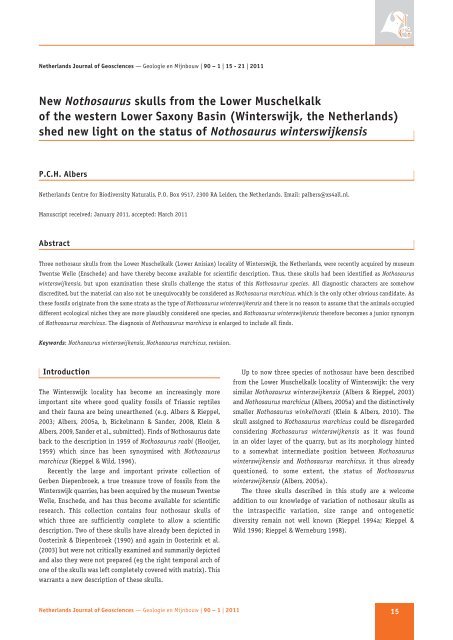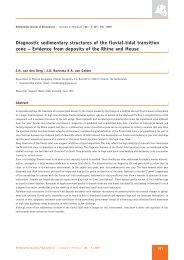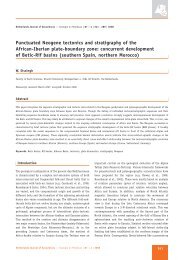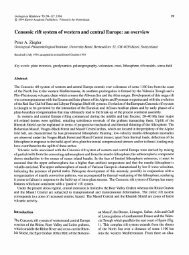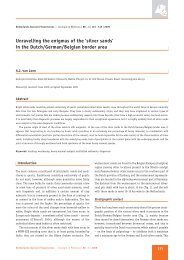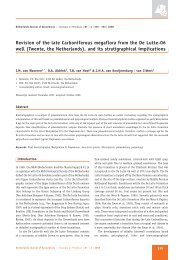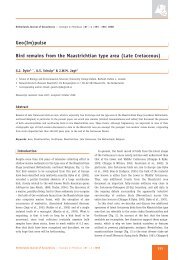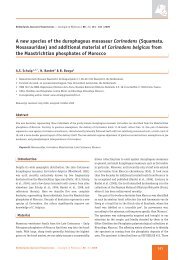full text - Netherlands Journal of Geosciences
full text - Netherlands Journal of Geosciences
full text - Netherlands Journal of Geosciences
Create successful ePaper yourself
Turn your PDF publications into a flip-book with our unique Google optimized e-Paper software.
<strong>Netherlands</strong> <strong>Journal</strong> <strong>of</strong> <strong>Geosciences</strong> — Geologie en Mijnbouw | 90 – 1 | 15 - 21 | 2011<br />
New Nothosaurus skulls from the Lower Muschelkalk<br />
<strong>of</strong> the western Lower Saxony Basin (Winterswijk, the <strong>Netherlands</strong>)<br />
shed new light on the status <strong>of</strong> Nothosaurus winterswijkensis<br />
P.C.H. Albers<br />
<strong>Netherlands</strong> Centre for Biodiversity Naturalis, P.O. Box 9517, 2300 RA Leiden, the <strong>Netherlands</strong>. Email: palbers@xs4all.nl.<br />
Manuscript received: January 2011, accepted: March 2011<br />
Abstract<br />
Three nothosaur skulls from the Lower Muschelkalk (Lower Anisian) locality <strong>of</strong> Winterswijk, the <strong>Netherlands</strong>, were recently acquired by museum<br />
Twentse Welle (Enschede) and have thereby become available for scientific description. Thus, these skulls had been identified as Nothosaurus<br />
winterswijkensis, but upon examination these skulls challenge the status <strong>of</strong> this Nothosaurus species. All diagnostic characters are somehow<br />
discredited, but the material can also not be unequivocably be considered as Nothosaurus marchicus, which is the only other obvious candidate. As<br />
these fossils originate from the same strata as the type <strong>of</strong> Nothosaurus winterswijkensis and there is no reason to assume that the animals occupied<br />
different ecological niches they are more plausibly considered one species, and Nothosaurus winterswijkensis therefore becomes a junior synonym<br />
<strong>of</strong> Nothosaurus marchicus. The diagnosis <strong>of</strong> Nothosaurus marchicus is enlarged to include all finds.<br />
Keywords: Nothosaurus winterswijkensis, Nothosaurus marchicus, revision.<br />
Introduction<br />
The Winterswijk locality has become an increasingly more<br />
important site where good quality fossils <strong>of</strong> Triassic reptiles<br />
and their fauna are being unearthened (e.g. Albers & Rieppel,<br />
2003; Albers, 2005a, b, Bickelmann & Sander, 2008, Klein &<br />
Albers, 2009, Sander et al., submitted). Finds <strong>of</strong> Nothosaurus date<br />
back to the description in 1959 <strong>of</strong> Nothosaurus raabi (Hooijer,<br />
1959) which since has been synoymised with Nothosaurus<br />
marchicus (Rieppel & Wild, 1996).<br />
Recently the large and important private collection <strong>of</strong><br />
Gerben Diepenbroek, a true treasure trove <strong>of</strong> fossils from the<br />
Winterswijk quarries, has been acquired by the museum Twentse<br />
Welle, Enschede, and has thus become available for scientific<br />
research. This collection contains four nothosaur skulls <strong>of</strong><br />
which three are sufficiently complete to allow a scientific<br />
description. Two <strong>of</strong> these skulls have already been depicted in<br />
Oosterink & Diepenbroek (1990) and again in Oosterink et al.<br />
(2003) but were not critically examined and summarily depicted<br />
and also they were not prepared (eg the right temporal arch <strong>of</strong><br />
one <strong>of</strong> the skulls was left completely covered with matrix). This<br />
warrants a new description <strong>of</strong> these skulls.<br />
Up to now three species <strong>of</strong> nothosaur have been described<br />
from the Lower Muschelkalk locality <strong>of</strong> Winterswijk: the very<br />
similar Nothosaurus winterswijkensis (Albers & Rieppel, 2003)<br />
and Nothosaurus marchicus (Albers, 2005a) and the distinctively<br />
smaller Nothosaurus winkelhorsti (Klein & Albers, 2010). The<br />
skull assigned to Nothosaurus marchicus could be disregarded<br />
considering Nothosaurus winterswijkensis as it was found<br />
in an older layer <strong>of</strong> the quarry, but as its morphology hinted<br />
to a somewhat intermediate position between Nothosaurus<br />
winterswijkensis and Nothosaurus marchicus, it thus already<br />
questioned, to some extent, the status <strong>of</strong> Nothosaurus<br />
winterswijkensis (Albers, 2005a).<br />
The three skulls described in this study are a welcome<br />
addition to our knowledge <strong>of</strong> variation <strong>of</strong> nothosaur skulls as<br />
the intraspecific variation, size range and ontogenetic<br />
diversity remain not well known (Rieppel 1994a; Rieppel &<br />
Wild 1996; Rieppel & Werneburg 1998).<br />
<strong>Netherlands</strong> <strong>Journal</strong> <strong>of</strong> <strong>Geosciences</strong> — Geologie en Mijnbouw | 90 – 1 | 2011<br />
15
Description<br />
Institutional abbreviations<br />
TW = Museum Twentse Welle, Enschede<br />
Described material<br />
Four nothosaur skulls from the Diepenbroek collection in the<br />
museum ‘Twentse Welle’, Enschede, with collection numbers:<br />
TW480000375, TW480000376, TW480000377, and TW480000378.<br />
(Photographs in addendum online: www.njgonline.nl).<br />
Referred material<br />
Two additional skulls described as Nothosaurus winterswijkensis<br />
(Albers & Rieppel, 2003), one skull attributed to Nothosaurus<br />
marchicus (Albers, 2005a) and one skull described as Nothosaurus<br />
winkelhorsti (Klein & Albers, 2009).<br />
Stratum typicum<br />
The skulls were found in the Lower Wellenkalk layer 9 (Oosterink,<br />
1986), Vossenveld Formation (lower Anisian, lowermost Middle<br />
Triassic) in the ‘Winterswijkse Steen- en Kalkgroeve, Winterswijk,<br />
<strong>Netherlands</strong>’, a quarry <strong>of</strong> the Ankerpoort consortium; see also<br />
the tectonic map and geological pr<strong>of</strong>iles <strong>of</strong> Harsveldt (1973).<br />
Gauss-Krüger coordinates: R 2252,6/H 5758,6.<br />
General remarks and measurements<br />
All four skulls are relatively small seized. Two skulls, are<br />
complete, one prepared in dorsal view (TW480000375) and one<br />
prepared in ventral view (TW480000376). The third skull is<br />
very incomplete and not diagnostic, its right temporal fenestra<br />
is intact and the corresponding frontal and parietal skull table<br />
and the medial outline <strong>of</strong> the orbits with the front broken <strong>of</strong>f<br />
just posterior to the external naris. A small part <strong>of</strong> the left side<br />
<strong>of</strong> the skull is present but below elements belonging to the<br />
palate eg the pterygoid and the basisoccipital are or appear to<br />
be completely missing. (see photograph in addendum online:<br />
www.njgonline.nl). The fourth skull (TW480000378) is complete<br />
except for most <strong>of</strong> the premaxilla. For estimation <strong>of</strong> sizes the<br />
missing premaxilla was considered to be <strong>of</strong> about equal size as<br />
that <strong>of</strong> TW480000375. See Table 1 for general measurements and<br />
Table 2 for derived measures and dentition. Unless specifically<br />
mentioned otherwise the descriptions below refer to skulls<br />
TW480000375 and TW480000378 when features in dorsal view<br />
are described and refer to TW480000376 when features in<br />
ventral view are described (see Fig. 1) .<br />
Premaxilla<br />
The paired premaxillas have long and slender tapering<br />
posterior processes, which reach far back along the skull<br />
midline, extending beyond the external naris. In dorsal view<br />
the anterior medial margin <strong>of</strong> the external naris is bordered by<br />
the premaxilla. Their posterior medial margin, however, is<br />
separated from the premaxilla by an anterior lateral tapering<br />
process <strong>of</strong> the nasal. The suture between premaxilla and maxilla<br />
is located slightly posterior to the anteroventral corner <strong>of</strong> the<br />
external naris, from where it extends in anterolateral<br />
direction. In ventral view it curves around the alveolus <strong>of</strong> the<br />
anteriormost maxillary tooth until about the height <strong>of</strong> the<br />
anterior margin <strong>of</strong> the internal naris, but remains excluded<br />
therefrom by a contact <strong>of</strong> the maxilla with the vomer at the<br />
anterior margin <strong>of</strong> the latter. The premaxilla carry five tooth<br />
positions, comprising four premaxillary fangs followed by a<br />
distinctly smaller premaxillairy tooth. Several teeth remain in<br />
situ (see figure) as well as one replacement visible in the<br />
alveolus <strong>of</strong> the fourth position on the left side <strong>of</strong><br />
TW480000376.<br />
Maxilla<br />
From posterior to the anteroventral corner <strong>of</strong> the external naris<br />
the maxilla reaches backwards carrying the tooth row until<br />
about 10-15% <strong>of</strong> the length <strong>of</strong> the longitudinal diameter <strong>of</strong> the<br />
upper temporal fenestra. The maxilla has a foramen at the<br />
anterior part along the lateral margin <strong>of</strong> the external naris,<br />
serving the exit <strong>of</strong> a lateral branch <strong>of</strong> the superior alveolar<br />
nerve, as is common in most species <strong>of</strong> Nothosaurus (Rieppel &<br />
Wild, 1996). Laterally the maxilla shows a slight bulge just<br />
behind the level <strong>of</strong> the posterior margin <strong>of</strong> the external naris,<br />
accommodating the roots <strong>of</strong> the maxillary fangs. Behind the<br />
external naris, the maxilla meets the lateral margin <strong>of</strong> the nasal<br />
in a posteromedially trending suture, until it meets the frontal,<br />
as is common for Nothosaurus marchicus (Rieppel & Wild, 1996),<br />
except for the left maxilla <strong>of</strong> TW480000375 were the maxilla is<br />
excluded from the frontal by a small anteromedial process <strong>of</strong><br />
the prefrontal, as typical <strong>of</strong> Nothosaurus winterswijkensis (Albers<br />
& Rieppel, 2003).<br />
In ventral view the maxilla forms the lateral margin <strong>of</strong> the<br />
internal naris and extends posteriorly lateral to the palatine<br />
and the ectopterygoid. The suture between the premaxilla and<br />
the maxilla is clearly identifiable on both sides <strong>of</strong> the skull <strong>of</strong><br />
TW480000376 and indicates four tooth positions (2 teeth in<br />
situ) before the maxillary fangs on the left side <strong>of</strong> the skull and<br />
five tooth positions (3 teeth in situ) before the maxillary fangs<br />
on the right side <strong>of</strong> the skull. Five tooth positions before the<br />
maxillary fangs are diagnostic for Nothosaurus marchicus<br />
(Rieppel & Wild, 1996). Lateral views <strong>of</strong> both other skulls<br />
(TW480000375 and TW480000378) do not seem to accommodate<br />
more room than three tooth positions (with either 1 or 2 teeth<br />
16<br />
<strong>Netherlands</strong> <strong>Journal</strong> <strong>of</strong> <strong>Geosciences</strong> — Geologie en Mijnbouw | 90 – 1 | 2011
Table 1. General measurements <strong>of</strong> nothosaur skulls from Winterswijk.<br />
Nothosaur skulls from the Winterswijk locality<br />
winterswijkensis 1 marchicus 2 TW480000375 TW480000376 TW480000378 winkelhorsti 3<br />
Tip <strong>of</strong> the snout to occipital condyle 126.7 130* 101.4 107 94* 46<br />
Tip <strong>of</strong> the snout to posterior margin 122.8 - 98.3 - 93* 45<br />
<strong>of</strong> supraoccipital<br />
Tip <strong>of</strong> the snout to posterior margin 113.3 116* 89.3 - 83* 41.8<br />
<strong>of</strong> parietal skull table<br />
Tip <strong>of</strong> the snout to anterior margin 71.8-73 67.2* 56 - 55* 26.3-27<br />
<strong>of</strong> upper temporal fossa<br />
Tip <strong>of</strong> the snout to anterior margin 41.8-43.7 41.3 31-31.2 - 33* 13.5-15<br />
<strong>of</strong> the orbit<br />
Tip <strong>of</strong> the snout to anterior margin 94.8 - 72.4 - 70* 33.1<br />
<strong>of</strong> the pineal foramen<br />
Tip <strong>of</strong> the snout to anterior margin<br />
<strong>of</strong> external naris 22.5-23.2 20.9 16.6-16.7 - 18* 6.25-7<br />
Tip <strong>of</strong> the snout to the anterior margin 26.3 26.7 19.7 20.4 - -<br />
<strong>of</strong> internal naris<br />
Width <strong>of</strong> skull across postorbital arches 49.2 46* 44.4 43.7 34.2 -<br />
Width <strong>of</strong> skull at anterior margin <strong>of</strong> orbits 35 36.2* 28.1 25 24.3 -<br />
Width <strong>of</strong> skull at roots <strong>of</strong> maxillary fangs 33.9-37 32.1* 26.4 25.9 21.1 -<br />
Width <strong>of</strong> skull at rostral constriction 19.6-22.4 19.3* 14.6 14.9 13.3 -<br />
Maximum width <strong>of</strong> premaxillary rostrum 22.5-23.2 20.7* 15.2 16.9 - -<br />
Longitudinal diameter <strong>of</strong> external naris 10.4-12.8 10.4 7.5-8 - 7.1-8.4 2-2.2<br />
Transverse diameter <strong>of</strong> external naris 7.5-9.4 9.7 6.2-6.4 - 3.4-5.2 1.25-1.3<br />
Longitudinal diameter <strong>of</strong> orbit 21.9-22.8 21.2 18.1-19.4 - 15.8-16.3 2-10.5<br />
Transverse diameter <strong>of</strong> orbit 13.7-14.7 13.2 12.2 - 8.8-10.7 3.3<br />
Longitudinal diameter <strong>of</strong> upper temporal fossa 46.3 48* 38.5-39.2 - 32.4-34 14-16<br />
Transverse diameter <strong>of</strong> upper temporal fossa 16 17 13.3 - 9.9-10.6 -<br />
Longitudinal width <strong>of</strong> the pineal foramen 4.6 - 2.9 - 2.3 1.7<br />
Transverse width <strong>of</strong> the pineal foramen 2.9 - 2.2 - 1.7 0.5<br />
Longitudinal diameter <strong>of</strong> internal naris 10.8-11.4 11.7 - 8.7-9.2 - -<br />
Transverse diameter <strong>of</strong> internal naris 4.1-4.4 4.5* - 3.6-3.9 - -<br />
Distance from posterior margin <strong>of</strong> external 10.2-10.3 10 7.2-7.6 - 6.6-8.9 5.25-5.3<br />
naris to anterior margin <strong>of</strong> orbit<br />
Distance from posterior margin <strong>of</strong> orbit 8.8-9.1 8 7.5-7.8 - 6.5-6.8 3.8-3.5<br />
to anterior margin <strong>of</strong> upper temporal fossa<br />
Middorsal bridge between external nares 6.2 3.9* 3.9 - 3.8 2.5<br />
Middorsal bridge between orbits 8.1-10 13* 8.6 - 6.7 3.5<br />
(minimum width)<br />
Middorsal bridge between upper temporal 2.9 - 4.8 - 2.8 3.4<br />
fossae (behind the pineal foramen)<br />
* Estimation based on extrapolation <strong>of</strong> the material at hand.<br />
1 (Albers & Rieppel, 2003).<br />
2 (Albers, 2005a).<br />
3 (Klein & Albers, 2009).<br />
preserved in situ), which is diagnostic for Nothosaurus<br />
winterswijkensis (Albers & Rieppel, 2003). Behind the two<br />
maxillary fang positions 13 to 19 tooth positions can be<br />
estimated, but neither skull is sufficiently well prepared to<br />
give an exact number <strong>of</strong> tooth positions. As to the description<br />
<strong>of</strong> tooth elements from both premaxilla and maxilla: the fangs<br />
are conical, pointed and recurved. The enamel surface <strong>of</strong> the<br />
fangs is covered with longitudinal striations. The ‘normal’ teeth<br />
are also pointed but not re-curved, and their surface is smooth.<br />
The tooth implantation is thecodont.<br />
<strong>Netherlands</strong> <strong>Journal</strong> <strong>of</strong> <strong>Geosciences</strong> — Geologie en Mijnbouw | 90 – 1 | 2011 17
Table 2. Skull proportion and dentition.<br />
Nothosaurus<br />
winterswijkensis 1 marchicus 2 TW480000375 TW480000376 TW480000378 winkelhorsti 3<br />
Snout – external naris<br />
Rostral constriction 1.08 1.04-1.15 1.14 1.17* 1.35* 1.1-1.4<br />
Snout – orbit<br />
Snout – external naris 1.98 1.86-1.88 1.87 - 1.83* 1.8-2<br />
Snout – upper temporal fossa<br />
Snout – external naris 3.25 3.15-3.19 3.36 - 3.05* 2.9-3.4<br />
Longitudinal ∅ external naris<br />
Transverse ∅ external naris 1.07 1.33-1.40 1.23 - 1.89 1-1.4<br />
Premaxillary dentition ?(5)/4 + 1 4+1 4+1 4+1 ? 5<br />
Maxillary dentition 5+2+(21-?) 3+2+(19-21) 3+2+(13-?) 4/5+2+(18+?) 3+2+(10+?) 5+2+23<br />
1 From the Winterswijk locality (Albers, 2005a).<br />
2 (Albers & Rieppel, 2003).<br />
3 In general (Rieppel & Wild, 1996).<br />
Nasal<br />
Frontal<br />
The nasals form most <strong>of</strong> the posterior margin <strong>of</strong> the external<br />
nares and are carrying slender anteromedial processes which<br />
line the entire medial margin <strong>of</strong> the external nares. As<br />
described above the nasals laterally contact the maxillae and<br />
posteriorly they contact the frontal, except for TW480000375<br />
where the left nasal also contacts the prefrontal excluding the<br />
maxilla from the frontal.<br />
Prefrontal<br />
The prefrontals are short and slender elements, lining the<br />
anteriomedial third <strong>of</strong> the dorsal orbit. Noticable is that, as the<br />
previously mentioned, only on the left side <strong>of</strong> TW480000375 a<br />
small anteromedial process <strong>of</strong> the prefrontal, as typical <strong>of</strong><br />
Nothosaurus winterswijkensis (Albers & Rieppel, 2003) excludes<br />
the maxilla from the frontal.<br />
Jugal<br />
The contacts between the frontals and maxilla and prefrontal<br />
have been extensively ascribed above. Their medial margins<br />
meet the antero-lateral margin <strong>of</strong> the nasals, and their lateral<br />
margins run parallel to the medial prefrontal. The body <strong>of</strong> the<br />
fused frontals forms an interorbital bridge and therefore<br />
separates the posterior prefrontal from the anterior part <strong>of</strong> the<br />
postfrontal. The medial processes <strong>of</strong> the frontals contact the<br />
parietal in a interdigitating suture.<br />
Postfrontal<br />
The postfrontal defines the posteromedial margin <strong>of</strong> the orbit.<br />
The posterior tip <strong>of</strong> the postfrontal is excluded from the<br />
anteromedial margin <strong>of</strong> the upper temporal fossa by a contact<br />
between postorbital and parietal.<br />
Postorbital<br />
In Nothosaurus winterswijkensis the jugal separates the posterior<br />
part <strong>of</strong> the maxilla from the postorbital and enters into the<br />
orbit completely excluding the maxilla from the postorbital<br />
(Albers & Rieppel, 2003). In Nothosaurus marchicus the maxilla<br />
and the postorbital meet close to the edge and thereby excluding<br />
the jugal from the orbit (Rieppel & Wild, 1996; Albers & Rieppel,<br />
2003). In TW480000378 however the jugal does not enter the<br />
orbit on the left side but does enter the orbit on the right side.<br />
In TW480000375 the jugal clearly enters the orbit on both sides<br />
and in TW480000378 the jugal seems to enter the orbit on the<br />
right side when the skull is examined in lateral view (but due<br />
to the solely ventral preparation the view is not optimal; on<br />
the left side the orbit is not visible).<br />
The postorbital has a broad medial process that forms almost the<br />
entire postorbital arch and thus defines the anterior margin <strong>of</strong><br />
the upper temporal fossa as well as the posterolateral margin <strong>of</strong><br />
the orbit. Anteriorly, the postorbital contacts the jugal, and<br />
posteriorly the postorbital enters the upper temporal arch.<br />
Parietal<br />
The parietal is unpaired (fused). The parietal diverges posteriorly<br />
to meet the squamosal at the posterior margin <strong>of</strong> the upper<br />
temporal fossa. Sutures in the occipital area are not very clear<br />
but the parietal does not seem to markedly deviate from<br />
Nothosaurus winterswijkensis or Nothosaurus marchicus, which<br />
do not differ in this respect. The position <strong>of</strong> the pineal foramen<br />
<strong>of</strong> TW480000375 is almost at the center <strong>of</strong> the parietal<br />
18<br />
<strong>Netherlands</strong> <strong>Journal</strong> <strong>of</strong> <strong>Geosciences</strong> — Geologie en Mijnbouw | 90 – 1 | 2011
A<br />
Fig. 1. Three skulls <strong>of</strong> Nothosaurus<br />
marchicus. A – TW480000375 in<br />
dorsal view; B – TW480000376 in<br />
ventral view; C – TW480000378 in<br />
dorsal view. bo, basisoccipital; eo,<br />
exoccipital; ec, ectopterygoid; f,<br />
frontal; j, jugal; ju.f., jugular<br />
foramen; m, maxilla; n, nasal; op,<br />
opistothic; p, parietal; pmx,<br />
premaxilla; po, postorbital; p<strong>of</strong>,<br />
postfrontal; prf, prefrontal; pt,<br />
pterygoid; q, quadrate; sq,<br />
squamosal. Filled in circles next to<br />
the skull represent tooth elements<br />
visible in lateral view, open circles<br />
represent assumed tooth positions.<br />
Scale bar represents 5 cm.<br />
B<br />
C<br />
(plesiomorphic position) whereas in TW480000378 this position<br />
is somewhat shifted backward closer to the posterior margin <strong>of</strong><br />
the parietal skull table.<br />
Squamosal<br />
The squamosal defines most <strong>of</strong> the posterior margin <strong>of</strong> the upper<br />
temporal fossa. Its anterior extent within the upper temporal<br />
reaches almost until the anterior margin <strong>of</strong> the temporal fossa<br />
where it meets the postorbital. On the left side <strong>of</strong> TW480000378<br />
however it even seems to contact the posteromedial part <strong>of</strong> the<br />
jugal, but sutures in that area are not clear.<br />
Posteriorly, sutures are not very clear but the squamosal<br />
does again not seem to markedly deviate from Nothosaurus<br />
winterswijkensis or Nothosaurus marchicus, which do not differ<br />
in this respect.<br />
Vomer<br />
The paired vomers are elongate elements, which separate the<br />
internal nares from one another. The tapering anterior end <strong>of</strong><br />
the vomer enters between the premaxillae, forming two clear<br />
grooves. Behind the internal nares, the broad body <strong>of</strong> the vomer<br />
extends between the pterygoids for a distance that slightly<br />
exceeds the longitudinal diameter <strong>of</strong> the internal nares.<br />
Posteriorly the vomer sutures with the palatine and with<br />
more deeply interdigitating sutures contacts the anterior end<br />
<strong>of</strong> the pterygoid.<br />
Palatine<br />
The palatine forms the posterior margin <strong>of</strong> the internal naris<br />
with a shallow choanal groove.<br />
<strong>Netherlands</strong> <strong>Journal</strong> <strong>of</strong> <strong>Geosciences</strong> — Geologie en Mijnbouw | 90 – 1 | 2011 19
Posteriorly the palatine is embraced by the maxilla,<br />
ectopterygoid, and pterygoid.<br />
Ectopterygoid<br />
The sutures <strong>of</strong> the ectopterygoid are not clearly identifiable<br />
but seem to stretch anteriorly along half the length <strong>of</strong> the<br />
palatine.<br />
Pterygoid<br />
The pterygoid seems to form a weakly developed transverse<br />
process that, together with the ectopterygoid, forms a<br />
ventrally projecting (ecto)pterygoid flange. The shape <strong>of</strong> the<br />
pterygoid itself corresponds to the characteristic nothosaurian<br />
pattern (Rieppel & Wild, 1996). At their posterior extremity the<br />
pterygoids meet in an interdigitating suture common to all<br />
Nothosaurus species.<br />
Quadrate and occipital area<br />
The quadrate and the occipital area are difficult to ascertain<br />
exactly as sutures are not always very clear and/or preparation<br />
has not been optimal. However what can be seen is that the<br />
general plan does not markedly deviate from what is known<br />
Nothosaurus winterswijkensis or Nothosaurus marchicus, nor<br />
are these characters considerd important diagnostic features<br />
for these species. I therefore will forego detailed descriptions<br />
on elements as quadrate, basoccipital, basisphenoid, exoccipital,<br />
jugular foramen, opisthotic, supraoccipital and saggital crest.<br />
Discussion<br />
The propotions and descriptions <strong>of</strong> the newly described skulls<br />
suggest them to be either Nothosaurus winterswijkensis or<br />
Nothosaurus marchicus (see Tables 1 and 2). However none <strong>of</strong><br />
the skulls presented here can unequivocally be fitted to the<br />
diagnostic characters <strong>of</strong> neither Nothosaurus winterswijkensis<br />
nor Nothosaurus marchicus. But tending more towards<br />
Nothosaurus marchicus, a new problem arises as these were all<br />
found in the same ‘layer 9’. The presence <strong>of</strong> Nothosaurus<br />
marchicus in the Winterswijk locality could s<strong>of</strong>ar be explained<br />
as the only find came from a different (older) layer and<br />
therefore the species would not coincide with Nothosaurus<br />
winterswijkensis (Albers, 2005a). But naming any <strong>of</strong> the new<br />
skulls Nothosaurus marchicus would no longer leave room for<br />
the assumption that the two nothosaurs occupied different<br />
ecological niches. The most parsimonious conclusion therefore<br />
is to consider Nothosaurus winterswijkensis synonymous with<br />
Nothosaurus marchicus and widen the description <strong>of</strong> the<br />
characters <strong>of</strong> Nothosaurus marchicus. In particular whether or<br />
not the jugal enters the orbit has been shown to be variable<br />
even within one skull (TW480000378 left no, right yes) and the<br />
number <strong>of</strong> maxillary teeth preceding the maxillary fangs can<br />
also variate within one skull (TW480000376, 4 left, 5 right) as<br />
can the maxilla reaching the frontal (TW480000375, left no,<br />
right yes). Rieppel and Wild (1996) already mentioned a<br />
Nothosaurus marchicus-like skull from Mühlhausen depicted in<br />
Jaekel (1911; the fossil can no longer be located) that also has<br />
the jugal entering the orbit as well as the more forward<br />
(plesiomorphic) position <strong>of</strong> the pineal foramen, which further<br />
underlines the large variability possible with regard to the<br />
skull sutures. Furthermore, the jugal entering the orbit is also<br />
known to be a variable character in the genotypical species<br />
Nothosaurus mirabilis Rieppel, 1994; Rieppel & Wild, 1996).<br />
N. marchicus is very common in the entire Lower Muschelkalk<br />
<strong>of</strong> the Germanic Basin and has a large geographic distribution<br />
in the Anisian <strong>of</strong> Central Europe (Rieppel & Wild, 1996; Rieppel,<br />
2000). With regard to the phylogenetical position <strong>of</strong> the<br />
Nothosaurus marchicus no big change is to be expected as<br />
Nothosaurus marchicus and Nothosaurus winterswijkensis were<br />
already much more similar to each other than to any other<br />
nothosaur, and therefore very closely linked. But given the<br />
large variability within Nothosaurus marchicus, some <strong>of</strong> the<br />
other species, which only rest on very few specimens, may well<br />
become questionable in the future if more specimens become<br />
available.<br />
Concluding systematic palaeontology<br />
Specimens TW480000375, TW480000376, and TW480000378<br />
belong to:<br />
– Order Sauropterygia OWEN, 1860<br />
– Suborder Eosauropterygia RIEPPEL, 1994<br />
– Family Nothosauridae BAUR, 1889<br />
– Genus Nothosaurus MÜNSTER, 1834<br />
– Species Nothosaurus marchicus KOKEN, 1893<br />
Type species and specimen as stated in the revision <strong>of</strong><br />
Rieppel & Wild (1996: 34):<br />
Holotype: The specimen figured by Koken (1893, <strong>text</strong> figs 1,<br />
2, 3A: Pl. 10, figs 1-3) can no longer be located today. The<br />
counterslab, showing the impressions <strong>of</strong> the dorsal aspect <strong>of</strong><br />
the skull, is kept at the Natural History Museum, Humboldt<br />
University, Berlin (MB R. 2). […]<br />
Synonymy<br />
Nothosaurus winterswijkensis, Albers & Rieppel, 2003.<br />
Acknowledgements<br />
Bert Boekschoten and Constanze Bickelmann are greatly<br />
acknowledged for their constructive reviews.<br />
20<br />
<strong>Netherlands</strong> <strong>Journal</strong> <strong>of</strong> <strong>Geosciences</strong> — Geologie en Mijnbouw | 90 – 1 | 2011
References<br />
Albers, P., 2005a. A new specimen <strong>of</strong> Nothosaurus marchicus with features that<br />
relate the taxon to Nothosaurus winterswijkensis. www.PalArch.nl, Vertebrate<br />
Palaeontology, 3, (1): 1-7.<br />
Albers, P., 2005b. A placodontoid jaw fragment from the Lower Muschelkalk <strong>of</strong><br />
Winterswijk (the <strong>Netherlands</strong>). www.PalArch.nl, Vertebrate Palaeontology 3<br />
(5): 34-36.<br />
Albers, P. & Rieppel, O., 2003. A new species <strong>of</strong> the sauropterygian genus<br />
Nothosaurus from the Lower Muschelkalk <strong>of</strong> Winterswijk, the <strong>Netherlands</strong>.<br />
<strong>Journal</strong> <strong>of</strong> Paleontology 77: 738-774.<br />
Bickelmann, C. & Sander, M., 2008. A partial skeleton and isolated humeri <strong>of</strong><br />
Nothosaurus (Reptilia: Eosauropterygia) from Winterswijk, the <strong>Netherlands</strong>.<br />
<strong>Journal</strong> <strong>of</strong> Vertebrate Paleontology 28(2): 326–338.<br />
Baur, G., 1889. Palaeohatteria Credner, and the Proganosauria. American <strong>Journal</strong><br />
<strong>of</strong> Science 3(37): 310-313.<br />
Harsveldt, H.M., 1973. The middle Triassic Limestone (Muschelkalk) in the<br />
Achterhoek (E Gelderland) Verhandelingen van het Koninklijk Nederlands<br />
Geologisch Genootschap 29: 43-50.<br />
Hooijer, D.A., 1959. Records <strong>of</strong> nothosaurians from the Muschelkalk <strong>of</strong> Winterswijk,<br />
the <strong>Netherlands</strong>. Geologie en Mijnbouw 21: 37-39.<br />
Jaekel, O., 1911. Die Wirbeltiere. Eine Übersicht über die fossilen und lebende<br />
Formen. Gebr. Borntraeger, Berlin.<br />
Klein, N. & Albers, P.C.H., 2009. A new species <strong>of</strong>t he sauropsid reptile Nothosaurus<br />
from the Lower Muschelkalk <strong>of</strong>t he western Germanic Basin, Winterswijk, the<br />
<strong>Netherlands</strong>. Acta Palaeontologica Polonica 54: 589-598.<br />
Koken, E., 1893. Beiträge zur Kenntnis der Gattung Nothosaurus. Zeitschrift der<br />
deutschen geologischen Gesellschaft, 45: 337-377.<br />
Münster, G., 1834. Vorläufige Nachricht über einige neue Reptilien im Muschelkalke<br />
von Baiern. Neues Jahrbuch für Mineralogie, Geognosie, Geologie und<br />
Petrefaktenkunde 1834: 521-527.<br />
Oosterink, H.W., 1986. Winterswijk, Geologie deel II. De Trias-periode (geologie,<br />
mineralen en fossielen) Wetenschappelijke Mededeling van de Koninklijke<br />
Nederlandse Natuurhistorische Vereniging 178:1-120.<br />
Oosterink, H., Berkelder, W., De Jong, C. , Lankamp, J. & Winkelhorst, H., 2003.<br />
Sauriers uit de Onder-Muschelkalk van Winterswijk. In: Verenigung, N.G. (ed.):<br />
Staringia 11, Volume Jahrgang 57, Nummer 1a, Grondboor & Hamer, 146 pp.<br />
Oosterink, H. & Diepenbroek, G.H., 1990. Nieuwe vondsten uit de Winterswijkse<br />
Trias. Grondboor & Hamer 44(6): 150-154.<br />
Owen, R., 1860. Paleontology; or a systematic summary <strong>of</strong> extinct animals and<br />
their geologic remains. Adam and Charles Black, Edinburgh, XV + 420p.<br />
Rieppel, O., 1994. Braincases <strong>of</strong> Simosaurus and Nothosaurus: monophyly <strong>of</strong> the<br />
Nothosauridae (Reptilia, Sauropterygia). <strong>Journal</strong> <strong>of</strong> Vertebrate Paleontology<br />
14: 9-23.<br />
Rieppel, O., 2000. Sauropterygia I. In: Wellnh<strong>of</strong>er, P. (ed.): Encyclopedia <strong>of</strong><br />
Paleoherpetology, Volume 12A, Friedrich Pfeil (München), 134 pp.<br />
Rieppel, O. & Werneburg, R., 1998. A new species <strong>of</strong> the sauropterygian<br />
Cymatosaurus from the Lower Muschelkalk <strong>of</strong> Thuringia, Germany.<br />
Palaeontology 41: 575-589.<br />
Rieppel, O. & Wild, R., 1996. A revision <strong>of</strong> the genus Nothosaurus (Reptilia,<br />
Sauropterygia) from the Germanic Triassic, with comments on the status <strong>of</strong><br />
Conchiosaurus clavatus. Fieldiana: Geology 40: 1-85.<br />
Sander, M., Klein, N., Albers, P.C.H., Bickelmann, C. & Winkelhorst, H.<br />
(submitted). Postcranial morphology <strong>of</strong> a basal Pistosauroidea from the Lower<br />
Muschelkalk <strong>of</strong> Winterswijk, the <strong>Netherlands</strong> and a revised and extended<br />
phylogenetic analysis <strong>of</strong> Triassic Sauropterygia.<br />
<strong>Netherlands</strong> <strong>Journal</strong> <strong>of</strong> <strong>Geosciences</strong> — Geologie en Mijnbouw | 90 – 1 | 2011 21
Addendum<br />
Photo 1. TW480000375 in dorsal view.<br />
Photo 3. TW480000377 partial skull in dorsal view.<br />
Photo 4. TW480000378 in dorsal view.<br />
Photo 2. TW480000376 in ventral view.<br />
<strong>Netherlands</strong> <strong>Journal</strong> <strong>of</strong> <strong>Geosciences</strong> — Geologie en Mijnbouw | 90 – 1 | 2011


